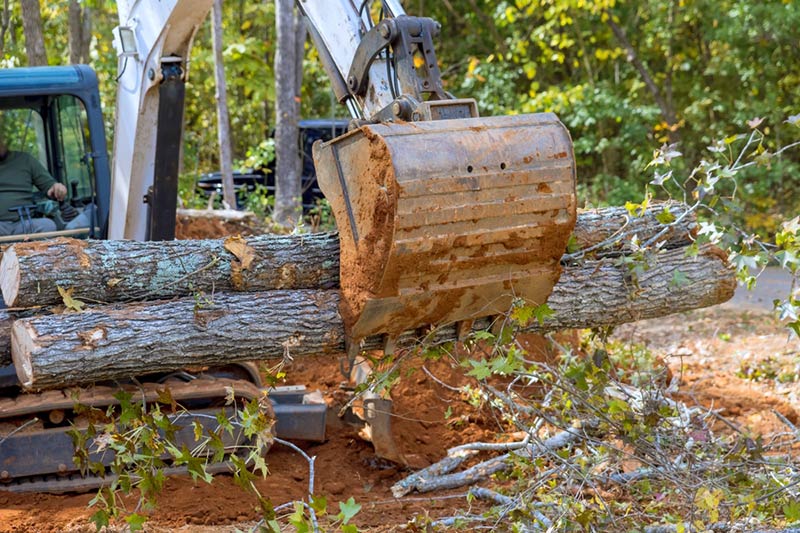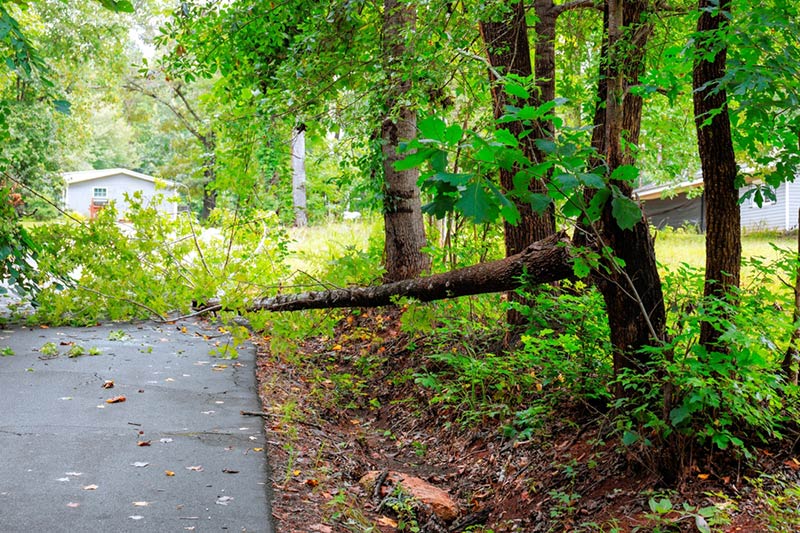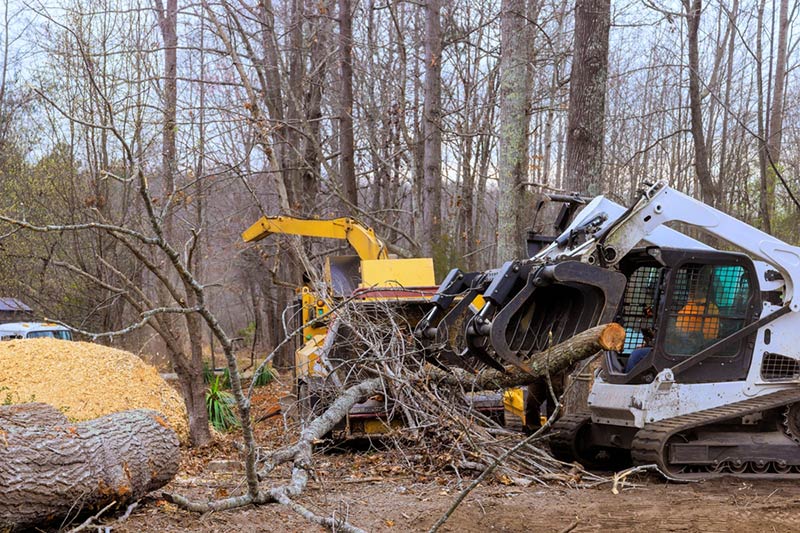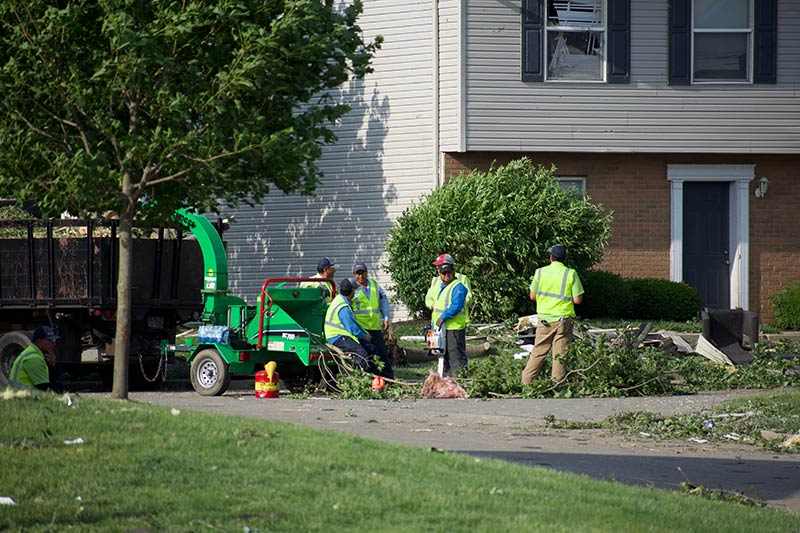Storms can leave behind a trail of destruction, from downed trees and blocked roads to damaged infrastructure and dangerous debris. Municipalities, utility companies, and private contractors must act quickly to restore access, remove hazards, and begin the process of community recovery. These operations often need to be carried out under urgent conditions, where safety, speed, and efficiency are equally important.
Heavy-duty mulchers are a valuable asset in storm cleanup because they can process fallen trees, broken branches, and dense vegetation directly on site. By cutting and shredding debris in a single pass, they eliminate the need for hauling large materials away and reduce the overall volume of waste. This speeds up recovery, lowers operational costs, and ensures that communities can return to normal as quickly as possible.

When severe weather strikes, the damage to infrastructure, landscapes, and community safety can be immediate and overwhelming. Fallen trees, tangled power lines, blocked roads, and scattered debris can halt daily life, disrupt emergency response, and create ongoing hazards if not addressed quickly. Post-storm recovery is a race against time, and municipalities, utility companies, and private property managers need solutions that combine speed, safety, and environmental responsibility.
Heavy-duty mulchers have become a vital part of modern storm cleanup strategies because they do more than simply remove debris. These machines transform large volumes of damaged vegetation into nutrient-rich mulch directly on site.
This approach not only clears hazards rapidly but also protects the soil, supports natural regeneration, and reduces the cost and complexity of debris disposal. Whether working in urban streets, rural farmland, or along utility corridors, heavy-duty mulchers deliver the speed and adaptability that storm recovery demands.
These benefits also align with techniques used in fire prevention and firebreak creation, where vegetation management is critical to long-term land stability.
The hours immediately following a storm are critical for protecting lives and property. Roads may be blocked by uprooted trees, power lines can be entangled in broken branches, and unstable vegetation can pose serious risks to anyone nearby. Heavy-duty mulchers enable trained crews to respond quickly and safely, clearing access routes for emergency responders and restoring critical connections for affected communities.
By operating in challenging terrain and processing debris in place, these machines eliminate the need for multiple trips with hauling equipment, reducing the time between damage assessment and hazard removal. Key safety and access benefits include:
A rapid, well-coordinated mulching operation after a storm not only reduces the risk of injury but also accelerates the broader recovery process by allowing other restoration teams to do their work without obstruction.
This capability mirrors approaches used in roadside vegetation management, where safety and access are restored with minimal delay.
Storms often strip landscapes of vegetation, leaving bare, unstable soil that is vulnerable to erosion and invasive species. Traditional cleanup methods such as burning or hauling debris away may remove hazards, but they also take valuable organic matter out of the ecosystem. Heavy-duty mulchers provide a more sustainable alternative by leaving a protective mulch layer exactly where it is needed.
This mulch cover delivers a range of ecological benefits:
By keeping nutrients on site and creating a stable, protective ground cover, heavy-duty mulching transforms storm debris from a disposal problem into a recovery resource. Over time, the mulch decomposes, enriching the soil and supporting a healthy, balanced ecosystem.
Post-storm recovery is one of the most logistically challenging forms of vegetation management. Cleanup crews are often deployed into unpredictable, high-risk environments where speed, safety, and adaptability determine how quickly communities can return to normal. Mud-soaked terrain, downed power lines, blocked access routes, and unstable structures are common obstacles. In these conditions, heavy-duty mulchers prove their value as an indispensable recovery tool. They combine the ability to clear hazardous vegetation with the precision needed to protect infrastructure, all while operating under extreme time constraints.
By processing vegetation on site and eliminating the need for multiple stages of removal, mulchers help recovery teams work faster and with fewer resources, allowing emergency and utility crews to restore essential services more quickly. Their design enables them to function efficiently in both open areas and confined spaces, making them a versatile asset in storm damage operations.
The same principles apply in remote access vegetation control, where terrain and time constraints demand maximum efficiency.

In the aftermath of a severe storm, every hour counts. Roads must be cleared for ambulances and supply trucks, power lines need to be accessible for repair crews, and public spaces must be made safe for residents. Heavy-duty mulchers excel in this high-pressure environment because they integrate cutting, shredding, and spreading into a single operation.
This eliminates the need to transport debris off site for chipping or burning, drastically reducing the overall recovery timeline.
Key speed and efficiency benefits:
This ability to accelerate debris clearance without sacrificing safety or quality allows municipalities, contractors, and utility companies to reallocate crews and equipment to other urgent recovery tasks sooner, restoring community functions faster.
These same efficiencies are applied in pipeline right-of-way maintenance, where access and safety must be restored with minimal downtime.
No two storm cleanup sites are alike. Crews may be tasked with clearing vegetation from flooded lowlands one day and working on steep, erosion-prone slopes the next. In many cases, debris will be entangled around damaged structures, guardrails, or electrical lines, requiring a method that balances power with precision.
Heavy-duty mulchers are engineered for these varied and unpredictable conditions.
They can also work safely near sensitive infrastructure, including power poles and drainage systems, using precise cutting controls. This precision is equally valuable in urban vegetation management, where damage to surrounding structures must be avoided.
Their adaptability is seen in their ability to:
This flexibility ensures that cleanup is not only fast but also thorough, reaching all the areas where hazards remain, including locations that would otherwise be inaccessible with conventional clearing equipment.

A successful storm cleanup project is built on two pillars: a well-structured plan and disciplined on-site execution. Even when working under urgent conditions, taking the time to plan strategically and adapt to real-time challenges ensures safer operations, faster recovery, and long-term site stability.
Heavy-duty mulchers are powerful tools, but their effectiveness depends on how they are deployed. A thoughtful approach not only prevents unnecessary damage to recovering landscapes but also maximises the impact of every hour spent in the field.
In the aftermath of a storm, speed is important, but safety and coordination take precedence. A rushed start without proper assessment can put crews, equipment, and the public at risk. Even a rapid site evaluation can uncover hazards that might otherwise cause costly delays or accidents.
Before machines enter the work zone, crews should:
This upfront coordination prevents dangerous work stoppages and ensures that cleanup crews can operate without interference, even in large-scale land clearing or high-priority emergency zones.
Once mulching begins, site conditions can change quickly. Shifting debris piles, flooding, or renewed wind activity can create new hazards. Crews must remain alert and flexible, adjusting techniques to ensure continued safety without losing momentum.
To maintain a safe and efficient workflow, teams should:
By combining strict adherence to safety protocols with adaptable work methods, storm cleanup crews can clear debris quickly while protecting both workers and the public. This disciplined approach also ensures that recovery efforts support long-term site health rather than causing additional damage.
Safety-focused operations may include adjusting cutting heights, monitoring weather patterns, and updating access routes in real time. These measures mirror protocols used in wind farm vegetation control, where work takes place in exposed, unpredictable environments.
“Storm cleanup is not just about removing debris, it is about restoring a sense of safety and normalcy for communities in the shortest possible time.”

Storm cleanup operations take place in unpredictable, often hazardous environments where both human safety and environmental protection must remain the top priorities. A well-executed debris management plan not only restores essential infrastructure quickly but also ensures that every step complies with safety standards and environmental regulations.
Heavy-duty mulchers provide a controlled and efficient method for processing storm debris, but their use must be guided by rigorous safety protocols and a clear understanding of legal requirements. This disciplined approach protects crews, safeguards communities, and preserves the integrity of the recovering landscape.
Post-storm environments often conceal hazards that can threaten both workers and the public. Fallen trees may be tangled in live power lines, weakened structures may collapse without warning, and floodwaters may carry contaminants or conceal unstable ground. Addressing these risks requires methodical safety measures that go beyond standard operational practices.
Crews should:
These precautions help ensure that cleanup activities are carried out in a controlled environment, reducing the risk of accidents and enabling crews to focus on restoring access and essential services.
Urgency in storm recovery must never come at the expense of environmental compliance. Cleanup operations are bound by environmental protection laws, waste management regulations, and, in some regions, special recovery guidelines designed to minimise ecological impact.
Mulching supports these objectives by processing debris directly on site, which:
By integrating mulching into storm debris management, recovery teams can meet legal requirements while supporting long-term environmental health. Regulatory compliance not only avoids costly penalties but also demonstrates a commitment to responsible, sustainable recovery practices,an essential factor in maintaining public trust after a disaster.
For more information on environmental compliance strategies, visit our resources page for operational guides and case studies.
When severe weather strikes, the speed and quality of your response can make the difference between a quick recovery and prolonged disruption. Our storm cleanup services with heavy-duty mulchers are designed to deliver immediate, professional, and environmentally responsible debris management for municipalities, infrastructure operators, and private property owners.
We offer:
Whether your priority is clearing blocked roads, reopening public spaces, or protecting critical infrastructure, we can create a tailored recovery plan that addresses your operational, safety, and environmental goals.
To provide the best experiences, we use technologies such as cookies to store and/or access device information. Consenting to these technologies will allow us to process data such as browsing behavior or unique IDs on this site. Failure to consent or withdrawing consent may adversely affect certain features and functions.